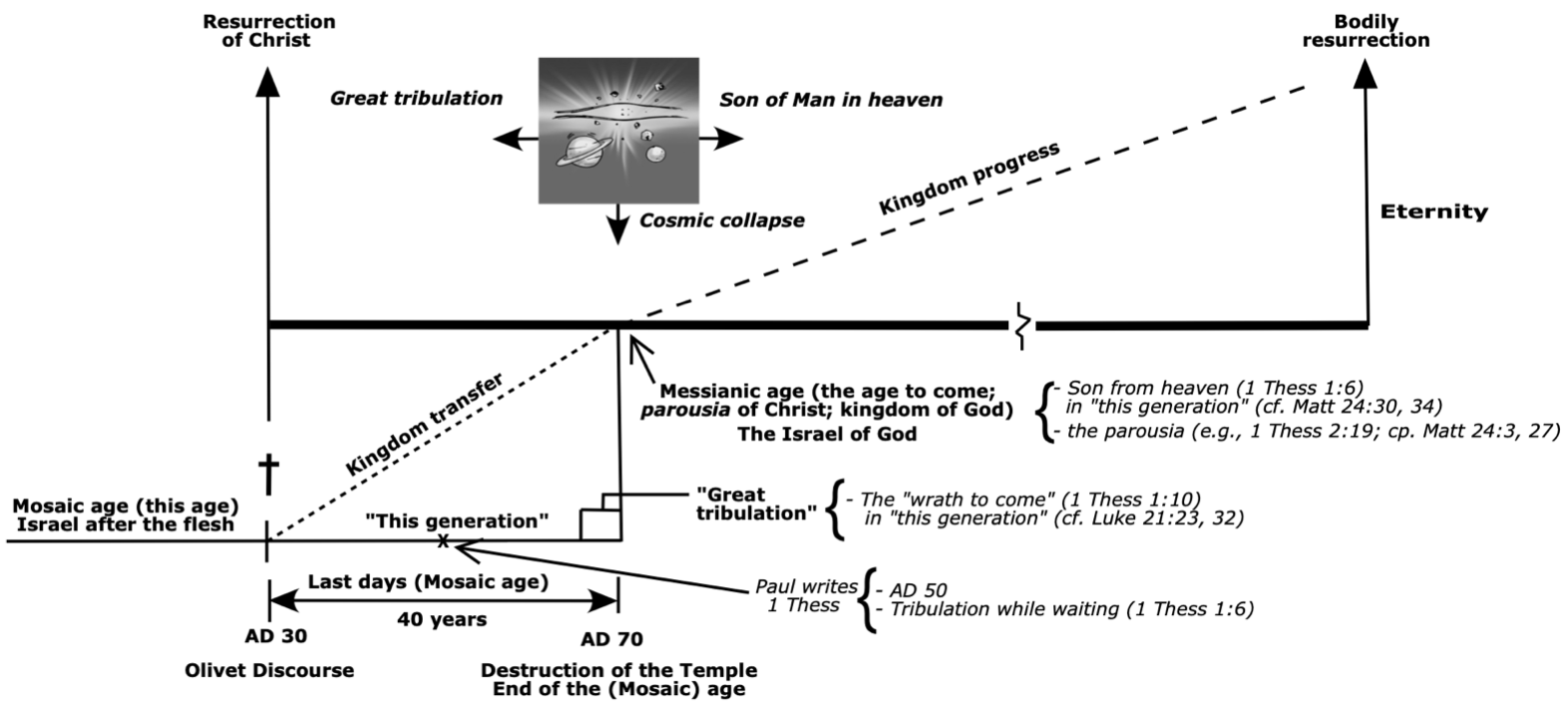
One of my goals in this series of posts on Thessalonians is to show that Paul wrote from the prophetic perspective I call inmillennialism. This prophetic model arises from Jesus’ Olivet Discourse1 and Paul’s discussion of the kingdom of God in 1 Corinthians 15. I have documented inmillennialism in previous blog posts,2 summarized it in a paper,3 and described it in detail in a book.4 The Thessalonian letters will tend to validate that model.
Sometimes the validation will be obvious as we will see in the so-called “rapture passage” (1 Thess 4:13–5:11). Paul’s numerous connections to the Olivet Discourse there are so obvious that D. A. Carson says, according to Jonathan Menn, “the Olivet Discourse ‘is undoubtedly a source for the Thessalonian Epistles.’”5 The correspondence between inmillennialism and Paul’s prophetic outlook is clear in such passages.
At other times, the compatibility between Thessalonians and inmillennialism is more subtle, as is the case in Paul’s references to tribulation in his second paragraph:
You … received the word in much tribulation (Gk. thlipsis) with the joy of the Holy Spirit…. And … [now] wait for His Son from heaven, whom He raised from the dead, that is Jesus, who rescues us from the wrath (Gk. orgē) to come. (1 Thess 1:6, 9–10 NASB)
Tribulation plays a vital role in Paul’s letters to the Thessalonians; I will have occasion to discuss it at length in future posts when I examine 1 Thessalonians 2:13–16; 3:3–4, 7; 5:2–3; et al. Here, I want to make a single point from his first reference to tribulation: Paul envisions the same two-fold tribulation Jesus described in the Olivet Discourse.
Inmillennialism refers to these two stages of tribulation as (1) “preliminary signs (Matt 24:4–14)—the beginning of birth pains”6 and (2) the “later sign (Matt 24:15–26)—the period of “the end.”7 The first phase would produce religious deceivers, social unrest, physical disturbances, persecution, and widespread apostasy as Jesus’ disciples preached the gospel of the kingdom to all nations. These signs would be the start of the messianic “birth pains” necessary to bring forth the messianic-age kingdom.8 Jesus had told his disciples what would happen during the period between his ascension and the temple’s fall (i.e., AD 30–70): “Then they will deliver you up to tribulation (Gk. thlipsis) and kill you, and you will be hated by all nations for My name’s sake” (Matt 24:9 NKJV).
Paul’s words to the Thessalonians—written around AD 509—conform to Jesus’ prophecy: he was preaching the gospel of the kingdom to them and, because they accepted the Apostle and his message, they were suffering “much tribulation (Gk. thlipsis)” (1 Thess 1:6). Paul later prayed “that no one be moved in these tribulations (Gk. thlipsis)” (1 Thess 3:3 YLT).
This first stage of tribulation was fulfilling Jesus’ prophecy in the Olivet Discourse. Here is the diagram from my book, Inmillennialism: Redefining the Last Days, that depicts this first wave of tribulation:10

Jesus had also prophesied of a second stage of tribulation: “For then shall be great tribulation (Gk. thlipsis megas)” (Matt 24:21). Luke’s account of the Olivet Discourse has the following warning about it: “But woe unto them that are with child, and to them that give suck, in those days! for there shall be great distress in the land, and wrath (Gk. orgē) upon this people” (Luke 21:23).
Jesus linked this phase of the tribulation to his messianic-age presence—his parousia—with this churches (Matt 24:27) and his “coming (Gk. erchomai) in the clouds of heaven” (Matt 24:30). This second phase of tribulation would complete the messianic birth pains that would produce the kingdom of God; it would occur in Jesus’ generation (Matt 24:34; Luke 21:32).
Paul’s letter to the Thessalonians again matches Jesus’ prophecy. The saints there had “turned to God from idols to serve the living and true God; and to wait for his Son from heaven” (1 Thess 1:9–10). This return of the “Son from heaven” is his coming (Gk. erchomai; 1 Thess 5:2; 2 Thess 1:10) that initiates his parousia (cp. 1 Thess 2:19; 3:13; 4:15; 5:23; 2 Thess 2:1, 8, 9).
And, just as Jesus had done in the Olivet Discourse, Paul links this parousia/coming to a time of intensified suffering: “Jesus … delivered us from the wrath (Gk. orgē) to come” (1 Thess 1:10). Robert L. Thomas makes an important point about the word Paul uses here:
Used technically, as it so frequently is in the NT, “wrath” (orgēs) is a title for the period just before Messiah’s kingdom on earth, when God will afflict earth’s inhabitants with an unparalleled series of physical torments because of their rejection of His will (Matt 3:7; 24:21; Luke 21:23; Rev 6:16, 17). That the wrath is pictured as “coming” or “approaching” carries out effectively the force of the present participle erchomenēs. It is already on its way and hence quite near. Throughout the Epistle, the events of Jesus’ future coming are imminent (cf. “we who are still alive, who are left,” 1Thess 4:15, 17).11
In my book, I used the following diagram to show this second phase of tribulation:

Brant Pitre provides an interesting side note to these observations. He surveys seventeen non-canonical Jewish documents written between 200 BC and 70 AD—writings that were circulating in Judea during Jesus’ generation. He then provides fourteen summary statements of his findings. Three of them relate to what I have been saying about tribulation. In these Jewish writings:
- “The tribulation is tied to the coming of a Messiah, sometimes referred to as the ‘Son of Man.’”
- “The tribulation has two stages: (1) the preliminary stage, and (2) the Great Tribulation.”
- “The tribulation precedes the coming of an eschatological kingdom.”12
Paul, as a well-read Jew, would have known about these writings and these expectations.
As we have seen in previous posts, after Jesus revealed himself to Paul, the Apostle updated his Jewish worldview. He can now tell the “church of the Thessalonians” that he knows their “election of God” (1 Thess 1:1, 4). He had formerly reserved these terms—“church” and “elect”—for Israel after the flesh (cf. Acts 7:38; Deut 7:6). Now he applies them to the “eschatologically reconstituted Israel”13 that God had created.
In 1 Thessalonians, Paul also adjusts the current Jewish view of the pre-kingdom tribulation. He links this time of suffering to the return of the Son of Man, but he now knows that Jesus is the Son of Man. He divides the tribulation into two stages and sees these as necessary to establish the kingdom. But he brings these beliefs under the control of Jesus’ Olivet Discourse. He knows the first stage of the tribulation is occurring as he preaches the gospel of the kingdom to the Thessalonians. The more intense wrath will come just before Jesus returns in that generation to destroy the temple. Paul knows that the unbelieving Jews “are always completing the number of their sins, and wrath (Gk. orgē) has overtaken them at last” (1 Thess 2:16 HCSB).
This two-fold view of tribulation shows the validity of the inmillennial prophetic model. In previous posts, I overlaid the contents of Hebrews (here and here) and Revelation (here) on the inmillennial prophetic model. I plan to do the same for the Thessalonian epistles. Here is the first installment:

Footnotes
- Matt 24–25; Mark 13:1–17; Luke 21:5–36.
- See the section Development Of A Prophetic Model.
- See A Summary of Inmillennialism.
- Inmillennialism: Redefining the Last Days, available in hardcopy here and as a PDF here.
- Jonathan Menn, Biblical Eschatology (Eugene, OR: Resource Publications, 2013), 94.
- Michael A. Rogers, Inmillennialism: Redefining the Last Days (Tullahoma, TN: McGahan Publishing House, 2020), 93.
- Rogers, Inmillennialism, 112.
- Rogers, Inmillennialism, 91–110.
- John A. T. Robinson, Redating the New Testament (Eugene, OR: Wipf & Stock Pub, 2000), 352.
- Rogers, Inmillennialism, 108.
- Robert L. Thomas, “1 Thessalonians,” in Ephesians–Philemon, vol. 11 of The Expositor’s Bible Commentary, ed. Frank E. Gaebelein (Grand Rapids: Zondervan, 1984), 248.
- Brant Pitre, Jesus, the Tribulation, and the End of the Exile: Restoration Eschatology and the Origin of the Atonement (Grand Rapids: Baker Academic; Tübingen: Mohr Siebeck, 2005), 128–29. Pitre lists a total of fourteen summary statements.
- Pitre, Jesus, the Tribulation, and the End of the Exile, 290.
